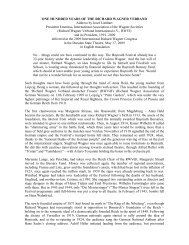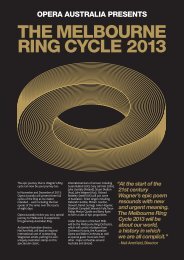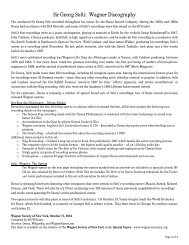Solti's Ring Remastered - Wagner Society of New York
Solti's Ring Remastered - Wagner Society of New York
Solti's Ring Remastered - Wagner Society of New York
Create successful ePaper yourself
Turn your PDF publications into a flip-book with our unique Google optimized e-Paper software.
However, it is possible to obtain superior sound by mastering at a higher sampling rate and bitdepth, before down-converting it to 44.1/16 for the CD. When the Solti <strong>Ring</strong> CDs were firstdigitized in 1984, the pr<strong>of</strong>essional mastering standard was 48/16. That was superseded by 48/20in 1993 and then supplanted in turn by 48/24 in 1996, which was the pr<strong>of</strong>essional standard at thetime the 1997 <strong>Ring</strong> CDs were prepared. A year later, in 1998, 96/24 mastering was introduced,which produced still further sonic improvement in transfers <strong>of</strong> analog originals. CDs preparedfrom 96/24 masters first appeared in 1999, in the Decca “Legends” and RCA “HighPerformance” series. Sampling at 96kHz made it possible to double the highest frequency thatcould be recorded – compared with 48kHz – giving more faithful reproduction <strong>of</strong> overtones andreducing distortion and artifacts caused by steep filters, an improvement that could be heard evenon conventional compact discs. Unfortunately, the 1997 <strong>Ring</strong> remastering occurred one year tooearly to take advantage <strong>of</strong> the new technology. (A few specialist audiophile labels have recentlybegun mastering stereo Blu-ray audio discs at an even higher resolution <strong>of</strong> 192/24.)Decca has been coy in refusing to reveal the sampling rate <strong>of</strong> the Blu-ray disc that comes withthe 2012 deluxe edition, stating in its ads and publicity material that the Blu-ray is “the complete<strong>Ring</strong> on one disc presented as lossless 24-bit files.” I have located a statement regardingtechnical specifications <strong>of</strong> the Solti <strong>Ring</strong> Blu-ray disc by Stefan Bock, the founder and managingdirector <strong>of</strong> msm-studios in Munich, Germany, the company to whom Decca contracted-out theauthoring <strong>of</strong> the Blu-ray edition. The <strong>Ring</strong> Blu-ray is 48/24. Mr. Bock, who supervised thetransfer <strong>of</strong> the Solti <strong>Ring</strong> to Blu-ray, was asked why the Blu-ray was encoded at 48/24 instead <strong>of</strong>the commonly used, superior 96/24 resolution. He responded as follows: “We have discussedwith Decca about delivering 24/96 files, as we would have loved to have this title in even higherresolution on Blu-ray. I was told that the restoration work on the analog tapes has been done in48k. So I think, the Blu-ray disc carries the best sound available.”ConclusionsAfter comparing the nine versions <strong>of</strong> Das Rheingold described above, it is appropriate to drawsome conclusions. All considered, purchasers will find the 2012 edition to be the best yet, but –had Decca taken the time, expense, and effort to return to the original analog master tapes tomake a new, state-<strong>of</strong>-the-art digital transfer – it could have been even better, especially at thehigh frequencies.Although engineer Philip Siney conscientiously enhanced the older, 1997 Cedarized digitalmaster tapes for the 2012 deluxe reissue, you can’t put back what has already been removed. Ifthe high frequency response has been attenuated, you can boost the high frequencies that remain,in order to counteract the dullness, but you can’t restore missing overtones that have beensheared <strong>of</strong>f by the Cedar process. A frequency analysis <strong>of</strong> the Blu-ray disc shows that the highfrequency spectrum <strong>of</strong> the contents was apparently rolled-<strong>of</strong>f sharply at 20kHz and cut <strong>of</strong>f by22kHz. The analog original tapes would have had a wider frequency response; a 96kHz Blu-raymade from them would have sounded noticeably better than a 48kHz Blu-ray, which is only anincremental improvement over the 44.1kHz sampling rate <strong>of</strong> the CDs.It strains credulity to accept the company’s explanation regarding the original analog stereomaster tapes that their “degradation had been significant, and it was deemed impossible to make






